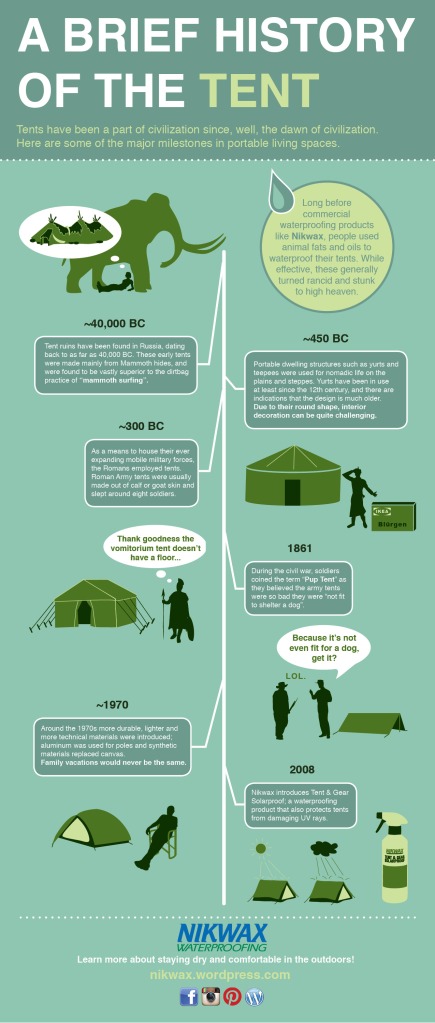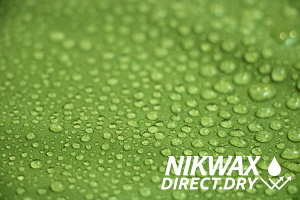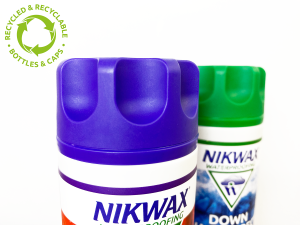The history of the tent is long and storied. From prehistoric times to recreational camping, tents have been a part of human comfort and survival. Check out our tent history infographic and read on to learn more!
Since the days Homo erectus, every kid throughout history has heard their parents squabbling over which tent pole goes where and would that gall-darned wind just stop blowing for one miserable minute so they could get the thing up.
A tent – first and foremost – provides the basic survival need of shelter. History’s first tent dwellers likely would have ditched their lean-to for an energy efficient stone cottage with a jetted bathtub and 500 channels on cable. Today’s tent dwellers (at least in North America) are typically looking to swap those modern trappings for an experience more evocative of a simpler time.
Of course, it’s easy to romanticize the notion of “simpler time.” The first evidence of tent construction can be carbon dated to around 40,000 B.C. While structurally rudimentary, the protective elements of the tents were made from Mammoth hides. Not so simple when your after-school chore consists of slaying, cleaning and sewing the hide of an 8-ton, 13-foot tall elephant.
Over the course of a few millennia, our ancestors realized the mammoth-motel lacked in some practical applications, like portability for their increasingly nomadic lifestyle. You just can’t hold a good Homo sapien down. Enter the yurt and the teepee (depending on your continent).
The hallmark of both the yurt and the teepee is ease of mobility. Folks from around 450 B.C. could follow the beast-du-jour migration or the seasonal flow of water. Essentially, early yurts and teepees served as the first iterations of the modern cab-over camper.
Yurt and teepee designs were sound enough to stand the test of time with minimal adaptation. To this day, Homo sapiens ‘Rocky Mountain hippie-ius’ still yearn for yurt living and backcountry yurt holidays.
As societies moved from nomadic to agrarian, complicated feats of portable architecture replaced simplistic engineering. With the species settling down, a tent came to symbolize a particular breed of wildness – whether as recreational pastime or enforced living.
Child labor could no longer be counted upon for preparing hides for the shelter, and the Industrial Revolution made heavy canvas and waxed fabrics easy to find. Tents were heavy, difficult to erect and inevitably stinky. Wall tents, still the preference of the military and many outfitters, loosely followed the form of the yurt and maximized indoor space. On the flip side, camping enthusiasts and outdoorspeople favored smaller versions of tent living. They sought structures falling somewhere between a teepee and a lean-to. These were still heavy and stinky, but less difficult to erect and better suited for turn of the 20th Century “light and fast” bragging rights.
Tent technology stayed fairly static until the fabric and materials revolution of the 1970’s. Nylon, which was invented by the DuPont Company in 1935, began its longtime reign as the go-to tent material. And the same tortured minds that brought us polyester leisure suits can be credited with a gigantic leap in making recreational tents lightweight and more weather resistant. Aluminum tent poles lightened the load even further.
Today, if you can dream of a perfect tent, there’s a good chance it already exists. Lightweight, portable and extremely weather resistant, we should all take a moment to thank our ancestors for the millennia of R&D to arrive at 2013’s tent technology.
The only concern is for today’s children. With tents so easy to erect, what will the youth of today do without the inevitable family fight the first time the tent is pitched in the backyard or the backcountry? We can only hope they’ll build new memories for a new generation.
*Nylon and polyester are truly wonder materials for your outdoor shelter needs. The main drawback is that these synthetic materials breakdown under UV light. Treat with Nikwax Tent and Gear SolarProof to guard against UV deterioration and to maintain water-repellency over the life of your tent.











Interesting post! I had no idea humans waterproofed using animal fats. Makes sense but gosh, that must have been nasty smelling.
The history of sleeping bags is also pretty interesting! The first “real” sleeping bag that was mass manufactured had an inflatable pillow in it! See: http://www.unclesamgear.com/2013/04/12/now-camping-gear-history/